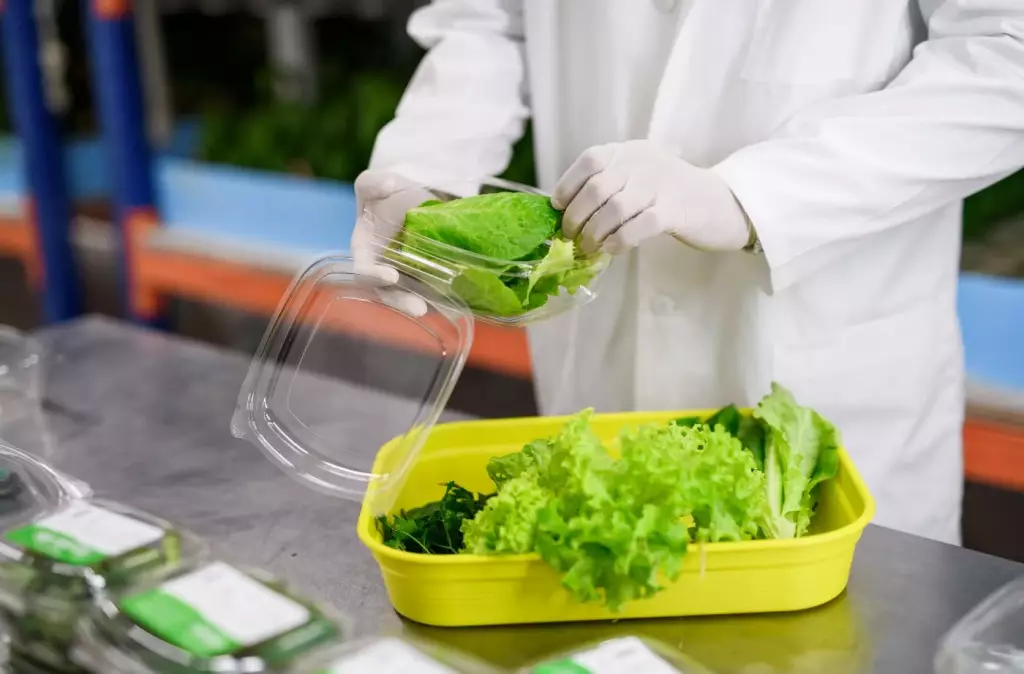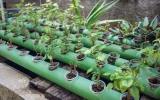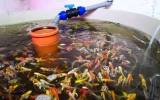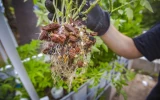Aquaponics Average Cost & Profit per Square Foot (2023)
The key to high aquaponics profit is to lower the cost of growing without compromising the quality and yield of your produce. What factors can we influence to improve costs and profits? In this article, we'll explore the average cost and profit per square foot, helping you better understand the financial implications of this unique method.
Typically, the cost per square foot for aquaponics ranges from $100 to $500, depending on the complexity of the design and the specific system components you choose. As for profitability, aquaponics can generate profits of $5-$10 per square foot per year. The earnings can be comparable to those of commercial hydroponics and aquaculture.
With aquaponic-grown lettuce potentially generating up to $16 per square foot of grow space or $20 for a case of 24 heads, focusing on high-value crops can make a significant difference in your returns. The global aquaponics market is also thriving, according to MarketWatch, Inc., with a predicted CAGR of 7.15% between 2023 and 2027.
Summary
- To determine the costs and potential profits of an aquaponics system, it's essential to consider the size and type of your setup, your location, and chosen crops.
- By seamlessly combining aquaculture and hydroponics, aquaponics offers a cost-effective way to grow high-quality produce and save on water and energy, all while minimizing environmental impact and without sacrificing yield.
- If you carefully plan and budget for both the initial setup and ongoing operating costs, you can better understand the profitability of your aquaponics system.

On this page:
Average Cost Per Square Foot of Aquaponics
Aquaponics, which combines aquaculture and hydroponics, has grown in popularity in recent years. You can greatly benefit from understanding the average cost per square foot if you're considering setting up your own aquaponics system.
Initial setup costs for aquaponics
The cost to set up your aquaponics system can range from $100 to $500 per square foot, depending on the system size and complexity. Some factors that may affect your initial setup costs include:
- Size of the aquaponics system
- Type of fish and plants to be cultivated
- Location and construction materials required
- Energy-efficient equipment such as water pumps and heating systems
Operating costs for aquaponics
These costs may vary depending on the scale of your operations, the energy efficiency of your equipment, and your overall management practices. However, some common operating costs associated with aquaponics include:
- Feed for fish
- Energy costs (heating, cooling, water pumps, and lighting)
- Water and waste management
- Maintenance and repairs of equipment
- Labor costs, if applicable
Profit Potential of Aquaponics in 2023

Aquaponics offers a promising future for sustainable food production. Understanding the average cost and profit per square foot of an aquaponics system can be essential for your success. In this section, we'll examine the factors that contribute to the revenue potential in aquaponics and share some tips on calculating your profit per square foot.
Revenue factors of an aquaponics system
Several factors impact the revenue potential of an aquaponics system. Some of the crucial factors include:
- Market demand: Research your local market to identify the most profitable crops for your area. For example, some profitable aquaponics crops in 2023 include herbs, salad greens, and specific varieties of fruit, such as strawberries.
- Cost-efficient setup: Choose an aquaponics system that offers the best balance of space, energy efficiency, and cost savings. Carefully plan your system to optimize growth rates while minimizing energy consumption and waste.
- Fish selection: Select fish species that are suitable for your climate and have a strong market demand. Some popular fish grown in aquaponics systems include tilapia, channel catfish, and hybrid striped bass.
- Yield: To increase your revenue, focus on maximizing the yield of your crops by optimizing growing conditions and using appropriate plant spacing.
Calculating profit per square foot
Calculating profit per square foot for an aquaponics system can give you a better understanding of the financial performance of your setup. To calculate the profit per square foot, follow these steps:
- Estimate the total revenue generated by your aquaponics system by multiplying the market value of each crop and fish species by their respective yield per square foot.
- Calculate the total cost of operating your system, including the costs of materials, equipment, energy, labor, and other operational expenses.
- Subtract the total cost from the total revenue to determine your gross profit.
- Finally, divide the gross profit by the total square footage of your aquaponics system to calculate the profit per square foot.
What Factors Influence Cost and Profit of Aquaponics
When looking at the average cost and profit per square foot of aquaponics systems, it's essential to consider several factors that can significantly influence these numbers.
Location of your setup

Your geographic location plays a vital role in determining the profitability of your aquaponics system. Regions where fresh produce is expensive, like the Virgin Islands and Hawaii, have a greater potential for profitable aquaponics businesses. Factors such as climate, access to resources, and local market potential should be considered when choosing your location.
System size of your setup
Smaller systems generally range in price from $1,500 to $15,000, while commercial systems can cost anywhere from $20,000 to over $100,000, depending on the size and location. It's crucial to strike a balance between system size and your expected market demand to ensure profitability and minimize unnecessary expenses.
Crop selection in your aquaponics setup
When you choose the right crops for your aquaponics system, focus on high-demand, high-value crops that cater to your target market's preferences. Take into account the growth rates, water requirements, and yield of each plant to ensure that you can maintain a healthy and productive system.
Efficiency and technology of the system
Improving the efficiency of your aquaponics system can lower your costs and increase your profit margins. Investing in technologies such as energy-efficient pumps, automation systems, and low-cost growing materials will help reduce operating costs without sacrificing the quality and yield of your produce.
Real-Life Examples and Case Studies of Aquaponics
These real-life examples and case studies will provide you with a clearer picture of what to expect when setting up your own system in 2023.
One interesting case comes from a small scale, low-cost aquaponic operation which was not economically viable due to higher operating costs of producing a kilogram of fish (R55). Their gross profit was 42%, net profit was -22%, ROI was -8%, NPV was R81,466, IRR was 13%, and Profitability Index was 0.35. This demonstrates that it is important for your system to be cost-effective and to focus on appropriate revenue distribution between fish and plants.
Another study of a designed pilot indoor aquaponic system in Belgium highlighted that energy consumption, infrastructure, and water consumption were the main issues affecting both environmental and economic performance. By paying close attention to these factors, you can optimize your system for better efficiency and profitability.

It's also worth noting that profitability can depend largely on geographic location. Studies show that aquaponics systems tend to be more profitable in areas like the Virgin Islands and Hawaii, where fresh produce is very expensive. To ensure the success of your aquaponics farm, you must find a market willing to pay a premium price for your produce.
Aquaponics can play a significant role in addressing food security, as demonstrated by a Namibian case study. Through efficient water usage and providing sustainable agriculture, aquaponics can be a valuable solution during droughts and help improve food security in challenging environmental conditions.
Ways to Maximize Your Profit in Aquaponics
In this section, we'll discuss some effective strategies to maximize your profit in aquaponics. We will focus on three key aspects: Scaling up, Adding Value to Your Products, and Minimizing Operational Expenses.
Scale up your aquaponics operation
One way to boost profit in aquaponics is by increasing the size of your operation. Instead of limiting yourself to a small-scale setup, consider expanding your system to increase production capacity. As your operation grows, you may benefit from economies of scale, which can help reduce your cost per unit produced. However, it's essential to manage growth carefully to ensure optimum efficiency and maintain the health of your fish and plants.
Add high-value crops to your setup
Another way to maximize your profit is to focus on producing high-value crops. Aquaponic-grown lettuce can yield a profit of up to $16 per square foot if you can produce premium leaves. Therefore, invest in the research and development of your crops, aiming to produce high-quality, nutritious, and aesthetically pleasing products that will attract customers and allow you to charge a premium price.
In addition, consider offering value-added products such as pre-packaged salad mixes, pesto made from your herbs, or ready-to-eat meals containing your fresh produce. By expanding your product range and improving the quality of your offerings, you can attract a wider range of customers and potentially increase your profit margins.
Minimize operational expenses

Keep your operational expenses low to achieve maximum profit per square foot. Here are some practical tips to help minimize your costs:
- Energy efficiency: Invest in energy-efficient equipment and practices, such as LED lights, solar panels, or efficient water pumps, to reduce your energy consumption and costs.
- Automate processes: Implement automation systems to save time and labor costs. For example, consider using automatic feeders, pH monitors, or nutrient dosing systems to streamline your operations.
- Optimized planting density: Adjust the planting density to make the best use of available space and resources. Too dense or too sparse can have a negative impact on your plants' growth and ultimately, your yield and profit.
- Effective pest management: Prevent and control pests without relying on expensive chemical treatments. Utilize natural methods, such as predatory insects, to keep pests under control while maintaining the quality of your produce.



